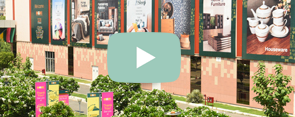बाजार की खबरें और रिपोर्ट
Mumbai world’s 12th most wealthy city, has the most ultra-millionaires in India: Report
Mohua Das | TNN | Mar 7, 2019, 09:12 IST
Source: Times of India dated 07.3.2019
MUMBAI: Even as distribution of wealth in India continues to be asymmetric, it seems the population of the rich is rapidly on the rise and swelling faster than in any other country.
According to the latest issue of The Wealth Report by Knight Frank, launched globally on Wednesday, Mumbai ranked as the world’s 12th most wealthy city, bettering its No. 18 spot in 2017, while London secured top position despite Brexit concerns, reclaiming it from New York.
India is also the leading country with 116% growth in its billionaire population and leads the growth of ultra high net worth individuals (UHNWI) globally.

While UHNWIs or ultra-millionaires are defined as individuals with Rs225 crore worth of investible surplus, billionaires are individuals with Rs7,200 crore worth of investible surplus, and millionaires are those with a Rs7.2 crore worth investible surplus.
If the number of UHNWIs in India is estimated at 1,947 at present, Mumbai houses 797 of them, Delhi 211 and Bengaluru 98, while out of the billionaire population of 119, Bengaluru is home to 33, Mumbai to 19, Delhi to 8 and the rest are scattered across the country and abroad.
Cities in India are often overshadowed by Mumbai’s success, but Bengaluru, often dubbed as India’s answer to Silicon Valley, is expected to disrupt the narrative. Bengaluru tops the list of five urban centres across the world that are likely targets for future property investment, followed by Hangzhou, Stockholm, Cambridge and Boston. While Mumbai still houses most of India’s millionaires and ultra-millionaires, Bengaluru is where concentration of India’s richest is to be found, with 33 billionaires who have made it their home.
Of 59 countries and territories for which forecasts have been made, eight of the top 10 are in Asia, with India leading with 39% growth in the next five years, followed by Philippines (38%) and China (35%).
Data from the ‘attitudes survey’ found 24% of Indian UHNWIs have property investments outside India, up from 21%, but their preferred avenues of investment for passion saw art topping the list.
Mumbai ranks as the 16th most expensive prime residential market in the world. Though the report states the city is expected to see a fall in prices this year, US$ 1mn can now buy about 100 sq. m. In Delhi the same amount can buy 201 sq. m, and Bengaluru is the most affordable of the three, with a potential of buying 334 sq. m.
Despite concerns over investment in the face of pollution reports and laying of metro tracks, Arvind Nandan, executive director of research for Knight Frank, India, said, “Creation of infrastructure always bolsters investment, even if it may seem troublesome now. The general environment has to offer a fillip and problems like pollution can make things difficult, but at the moment there are no symptoms deterring people.”
FMCG, auto products’ sales pick up pace in rural India, outsmart cities
By Sagar Malviya, Writankar Mukherjee, Ketan Thakkar, ET Bureau| Updated: Nov 22, 2017, 12.26 AM IST
This is the second consecutive quarter of double-digit growth in the rural FMCG market, which helped to boost volumes in the overall fast-moving consumer goods sector by 7%.
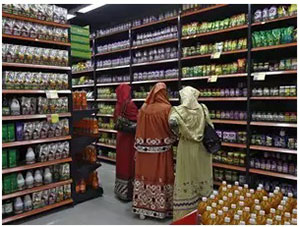 MUMBAI / KOLKATA: Purchases of consumer products and automobiles in rural India picked up pace during July-September, outstripping the rate in cities, as a good monsoon lifted farm income. Rural sales of FMCG products by both value and volume — the number of products sold — increased 13% during the quarter from a year earlier, according to Kantar Worldpanel, the consumer insights arm of WPP, the world’s biggest advertising company. It was the fastest pace of growth in over three years.
MUMBAI / KOLKATA: Purchases of consumer products and automobiles in rural India picked up pace during July-September, outstripping the rate in cities, as a good monsoon lifted farm income. Rural sales of FMCG products by both value and volume — the number of products sold — increased 13% during the quarter from a year earlier, according to Kantar Worldpanel, the consumer insights arm of WPP, the world’s biggest advertising company. It was the fastest pace of growth in over three years.
In contrast, the urban market expanded 4% by value and 1% by volume during this period, the researcher said.
This is the second consecutive quarter of double-digit growth in the rural FMCG market, which helped to boost volumes in the overall fast-moving consumer goods sector by 7% compared with about 4% a year earlier. The rural market accounts for more than a third of all consumer goods sold. “In our case, rural growth has been very good.
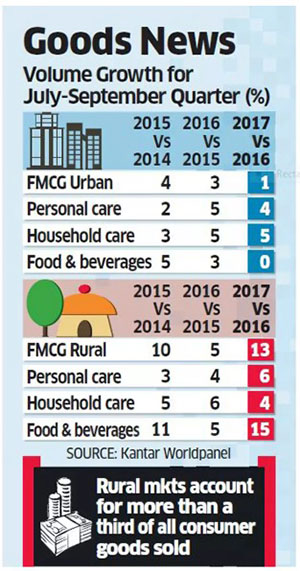 GST itself is creating demand. There are other factors also — the economy is doing well and overall, we are back to normal,” said Adi Godrej, chairman of the Godrej Group, which sells appliances, food and grocery and personal and home care products.
GST itself is creating demand. There are other factors also — the economy is doing well and overall, we are back to normal,” said Adi Godrej, chairman of the Godrej Group, which sells appliances, food and grocery and personal and home care products.
“Companies have become proactive by increasing direct distribution in rural areas as the headroom for penetration is very high compared to urban, which is saturated,” said Abneesh Roy, senior V-P, institutional equities, Edelweiss Securities.
Edelweiss Securities’ Abneesh Roy said direct benefit transfer (DBT) for job guarantee schemes and crop procurement, which eliminates pilferage, has put more money in the hands of rural customers. Urban consumption growth was constrained primarily by foods, while home care expanded by 5% and personal care by 4%, continuing their normal growth trajectory, said K Ramakrishnan, country head at Kantar Worldpanel.
“The drop in growth of foods was driven by high-volume categories like atta and rice, which have shown a marginal decline,” Ramakrishnan said. Food accounts for almost 70% of the total volume sales, according to the researcher. Auto companies and manufacturers of refrigerators and washing machines said rural purchases have increased.
Maruti Suzuki, which sells one in every two cars in the country, said rural sales grew faster than in urban areas at 22% so far this financial year, the highest in recent years.
“Two consecutive good monsoons, strong minimum support price and increasing availability of finance has ensured higher off-take in the rural markets. Led by new models and expanding network, we expect to sustain the momentum,” said RS Kalsi, senior executive director of sales and marketing at Maruti.“Double-digit growth in rural areas has offered a cushion to slowing urban sales,” said Rakesh Srivastava, director of sales and marketing at Hyundai Motor India.
ELECTRIFICATION DRIVE HELPS
While white goods and television sales went up by 12-13% in July-September, their growth in rural India during this period was 16-17%, as per industry data. Executives said sales growth in rural India exceeded that in urban areas for the past three quarters. “Low penetration level and good monsoon boosting farmer income has been the main reason behind this higher growth in rural India,” said LG India director-sales Rajeev Jain.
Another reason the industry cited was the electrification drive in smaller markets, which is boosting demand. Over the past decade, sales of branded daily-need products in the nation of 1.3 billion people have increasingly relied on the vast rural hinterland, home to about 800 million people whose purchasing behaviour depends on farm output. Therefore, annual monsoon rains that help irrigate India’s crops play a vital role in shaping buying patterns in Asia’s thirdbiggest economy. Below-average monsoon rains over the past couple of years had been blamed for stagnant sales growth.
To counter the impact of the currency note ban announced in November last year, finance minister Arun Jaitley announced incentives built around farm infrastructure and credit for rural and lowincome consumers. “We are now witnessing a revival in demand and consumption, led by the hinterland,” said Lalit Malik, chief financial officer at Dabur India, the maker of shampoos, hair oils, fruit juices and health supplements. “Riding on the back of a good monsoon last year, coupled with a slew of fiscal reforms and higher spending on infrastructure by the government, the rural economy is already showing signs of revival and has been growing ahead of the urban markets.”
SENTIMENT IMPROVING
Market sentiment is improving and stabilising after the introduction of GST, which consolidates multiple central and state taxes into one. “We expect the demand scenario to move up, in both the rural and urban markets,” Malik said. According to some companies, several unorganised makers of unbranded consumer products such as detergents, oil and soaps sold in the rural areas were slow to register with the GST network or failed to comply with the new tax structure, helping bigger firms gain market share. Changes in pricing after GST also helped rural growth as rates fell for some products.
“We believe that GST can be converted into a competitive advantage since we compete with a lot of unorganised players that are affected due to the new tax regime,” said Saugata Gupta, MD at Marico. “The company expects rural to contribute nearly 40% of sales in the next few years.” In the run-up to the introduction of GST, several consumer companies cleared inventory across trade channels, especially in the urban markets, amid uncertainty over pricing of goods produced before the start of the new tax regime. A few months ago, most companies said the pace of re-stocking was slower in the rural markets as wholesalers adapted to the transition. They expected the situation to stabilise by July-end.
Hindustan Unilever, which posted a 10% rise in sales in the second quarter of the financial year, said that it was difficult to break up the growth on the basis of demand and inventory change. “For the market to move up significantly, rural growth will have to move up because that is where the headroom to grow is the maximum,” HUL MD Sanjiv Mehta said last month.
Sales of air purifiers, masks skyrocket
The market for air purifiers is confined to northern India, which contributes close to 80% of the annual sales of Rs 500 crore
Arnab Dutta | New Delhi Last Updated at November 9, 2017 01:28 IST | Source: Business Standard
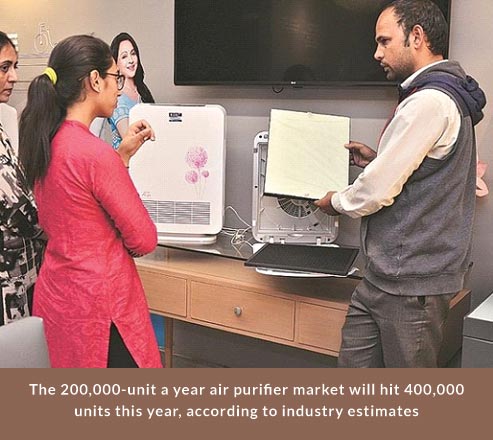
Air purifiers, masks and respirators have been flying off the shelves since the capital region has come under a thick layer of smog.
Since Monday, sale of air purifiers has doubled. When air quality worsened on Tuesday, marketers saw a 250 per cent jump in sales.
The market for air purifiers is confined to northern India, which contributes close to 80 per cent of the annual sales of Rs 500 crore. For the past few years, the market has been growing by more than 50 per cent. However, growing awareness among consumers — thanks to promotional activities by all major marketers — got more consumers into retail outlets this time. According to industry estimates, the 200,000 units a year market will hit 400,000 units this year. “We have sold some 7,000 pieces in November, which is 250 per cent higher than the sales in the same period last year,” said Kishalay Ray, president, consumer electronics division, Sharp Business Systems. “During October, too, year-on-year sale was better as we saw 2,800 units fly off the shelves. But sales have skyrocketed since yesterday.”
To cash in the growing demand for air-purifying systems, the firm had recently ventured into specialised categories, apart from car and room air-purifiers.
Other consumer durable makers were not too far behind. Korean major LG, Kent and Crompton Greaves have launched air-purifiers in the past few days. Kim-Ki Wan, managing director, LG Electronics India, said: “Air quality has been of pressing concern for consumers. Based on this insight, we have developed the latest LG air-purifiers.”
Syed Moonis Alvi, business head-purifiers, Panasonic India, said the firm has achieved sales of Rs 2 crore in October 2017, with a 20-25 per cent jump over last year. “We are targeting sales of Rs 7-8 crore till December 2017. We are at 8 per cent market share and hope to achieve 10 per cent market share by the end of 2017-18.”
Sudhir Pillai, a general manager at Honeywell Homes and Building Technologies, said: “Over the last two days, we have seen a more-than-fivefold spike in sales and 8-10-fold increase in enquires at our customer care centres. We are already selling aggressively through both online platforms as well as large and small-format retail stores.” Many shops ran out of stock of face masks and respirators. Jai Dhar Gupta, founder of Nirvana India, a seller of designer masks, said supply constraints were a concern as demand was seasonal.
Demonetisation Impact How Real?

Demonetisation of currency notes of Rs. 500 and 1,000 and their impact on the Indian economy, consumers and the government have been the most discussed subject in India since 8th of November. How has the reality compared with the apprehensions of severe impact on home textiles business?
Many leading retailers hold the view that retail business in home category, including home textiles, home decor and houseware will be highly impacted, with sales going down by over 50%. This is because majority of the purchases for such products were being done with unaccounted cash money, which will no more be available for spending. Not everyone agrees with such a view. Home Fashion spoke to some key retailers, brands and manufacturers to share their experiences with the readers:
Jagdish Khandelwal
Chairman, Jagdish Stores
After the sales going down steeply by 70% in the first 10-12 days since demonetisation, it has started recovering. Today it is at 50% of the pre demonetisationlevel.
Ratio of transaction has changed from 70% cash to 30% cash and balance by credit cards or a-payments.
Profile of customers is also undergoing a change. More younger, professional and business community is buying now, while the sales from Government officials has declined. Demand for high priced products is giving way to middle priced products. I see it as along term trend.
In my opinion, the impact will be in the short term. I foresee we closing this financial year (2016-17) sales going down by 25%, which will more than recover in the next financial year. The overall home textiles market will continue to grow in India, in fact, the growth may get further impetus, as people spend more confidently. However, the demand for expensive branded products will go down and middle and economy end products will increase in this new scenario. For some time, demand form high end architects and high end who will quickly switchover to e-payments in one form or the other. They are likely to invest more in adapting to better products and better lifestyle in the years ahead. Their numbers will only keep on increasing, and they in any case welcome a cleaner economic environment.
Nimish Arora
Managing Director, Dicitex Furnishings
Though the impact was high in the initial 1O days from the date of announcement of demonetisation, the recovery was equally quick. Today, after 40 days, we see a net impact of about 15-20% on our sales. This too should neutralize by the end of this financial year.
I think in the long term nothing will be impacted except those indulging in clandestine import through havala or under invoicing. I feel that genuine importers or representatives of premium international brands will also not be impacted much, as the genuine consumers will start buying again within a month or two.
For standard brands like ours there will be no long term impact as both retailers and consumers will return to buying sooner than later. Less Cash economy is here to stay. Therefore, buyers will be forced to change their paying habits to non-cash means. They cannot stop consuming.
Manoj Garg
Managing Director, Swayam Linen
With Swayam experience, we see the impact of demonetisationon our business in two parts. Short term and long term. Short term is what we are experiencing and long term is what we are contemplating. Swayam as a brand has two roles to play. One as a manufacturer, where we have to take care of our people in production. Here, since most of our 350 workers have a bank account, we did not face much difficulty. But since many of them had to go and stand in queues for long hours to withdraw their monies, we could not refuse them and this brought down our productivity by 10-15%. Besides, we faced some problems in sourcing small quantity of accessories in cash, as it was difficult to route them through banking system, which we do for most of our large purchases.
Second, as aretailer of our brand. Here, historically, post Diwali, sales always come down by about 15- 20%. This time it was down by 40%. Our experience was that our online sales also went down because many online retailers stopped cash on delivery. In fact, we did not see much impact in our sales through Large Format Stores, except for the first few days. I have been talking to several retailers across category. After first three weeks, December month now looks much better, and almost at par with our sales in last December. In fact, we may get amarginal improvement.
Vivek Khandelwal
Director, Floors & Furnishings
Frankly, as I talk to you on 22nd December, the impact of demonetisation on our business has not been as bad as we were expecting. It doesn’t mean we have had no impact. But recovery was much faster than we expected. November was extremely bad with sales going down by almost 60-70%. But in December first week we witnessed recovery process. We were quite worried because historically, in furnishing business over 80% sales have been in cash. To our pleasant surprise, many customers switched to digital payments, which we were not expecting to happen so soon. I was personally expecting things to improve only from February. Situation has been better than that. Today, our sale is down by 15-20%, but we are on arecovery path.
Mohit Modi
Managing Director, Spread Home
Initially, demonetisation certainly created an unpre cedented situation in home retail market. Retailers, specially the stand alone stores dealing with home decor & home textiles reported decline in sales upto 50-60%. Their repeat orders with us were virtually non-existent. Large Format Stores too have seen decline in sales, but their position was not that bad, and they are still paying us in time.
I felt that it will take quite some time before business comes back to normal, if at all. But I am glad that the recovery has been as dramatic as the fall. By December-mid, sales have recovered by 30-40%. We see unscrupulous importers going out of business, which gives us assurance of better business enviro nment and a fair competition in the years ahead0
द इकॉनॉमिक टाइम्स, 8 जुलाई, 2014, नई दिल्ली/कोलकाता
उपभोक्ता सामान के निर्माता अब गांवों में
दिलाशा सेठ और रितनाकर मुखर्जी
उपभोक्ता सामान के निर्माता ग्रामीण क्षेत्रों पर ध्यान देकर अधिक लाभ कमा रहे हैं, जहां नवीनतम आंकड़ों के अनुसार उत्पादों जैसे कार, मोटरसाइकिल और वहाइट गुड की ओनरशिप 2004-05 के मुकाबले 2011-12 में दो गुनी हो गई है, मगर शहरी बाजारों में बेहद कम पैठ दर्शाती है कि यहां विकास की संभावनाएं काफी अधिक हैं ….
रिटेल और वितरण की बदलती संरचना
अजय अरोड़ा, मैनेजिंग डायरेक्टर डी डेकोर
भारत में होम इंडस्ट्री तेजी से बदल रही है और ऐसा की रिटेलिंग में भी हो रहा है। यह बदलाव उच्च लेवल पर अधिक दिखाई देता है, जहां उपभोक्ता काफी जानकार होते हैं और अपनी पसंद और लाइफस्टाइल के अनुसार उत्पादों को खरीदने पर ज्यादा पैसा खर्च करना चाहते हैं। बडी़ संख्या में अंतर्राष्ट्रीय ब्रांड भारत में आ चुके हैं और संपूर्ण समाधान की पेशकश कर रहे हैं।
सोर्सिंग बढ़ाने के लिए आइकेया भारत में 12,500 करोड़ रुपये का निवेश कर रही है
होम फैशन इंडिया, जनवरी-मार्च 2015
वैश्विक होम फर्निंशिंग कंपनी आइकेया ने अगले दशक के दौरान भारत में 12,500 करोड़ रुपये का निवेश करने की घोषणा की है और यह भारत से अपनी सोर्सिंग बढ़ाने के लिए भी तैयार है। स्वीडन की कंपनी इसके लिए देश में अपने सप्लायर आधार का भी विस्तार कर रही है। जुवेासिओमेज्टू, आइकेया की भारतीय कंपनी के एक्जीक्यूटिव ने हाल ही में अमिताभ कांत, सचिव, औद्योगिक नीति और संवर्धन विभाग और वाणिज्य मंत्रालय के अन्य अधिकारियों से मुलाकात की है और भारत से सोर्सिंग बढ़ाने की अपनी योजना से उनको अवगत कराया। दिसंबर, 2014 में कंपनी ने ‘भारत में अधिक निर्माण” पहल की घोषणा की थी जिसका उद्देश्य संभावित पार्टनरों को आमंत्रित करना और भारत में आईकेया के सप्लायर आधार का विस्तार करना है।
आइकेया का उद्देश्य भारत में होम उत्पादों की श्रेणियों में भी वृद्धि करना है। वर्तमान में इसके पास भारत में 50 सप्लायर है और यह प्रतिवर्ष लगभग €315 मिलियन का माल मंगाती है। अब इसकर योजना 2020 तक इस राशि को डबल करने की है। कंपनी ने 25 होम स्टोर स्थापित करने की योजना की भी घोषणा की है और वह इसकी शुरूआत दिल्ली, मुंबई, बैंगलोर और हैदराबाद शहरों से करेगी।



